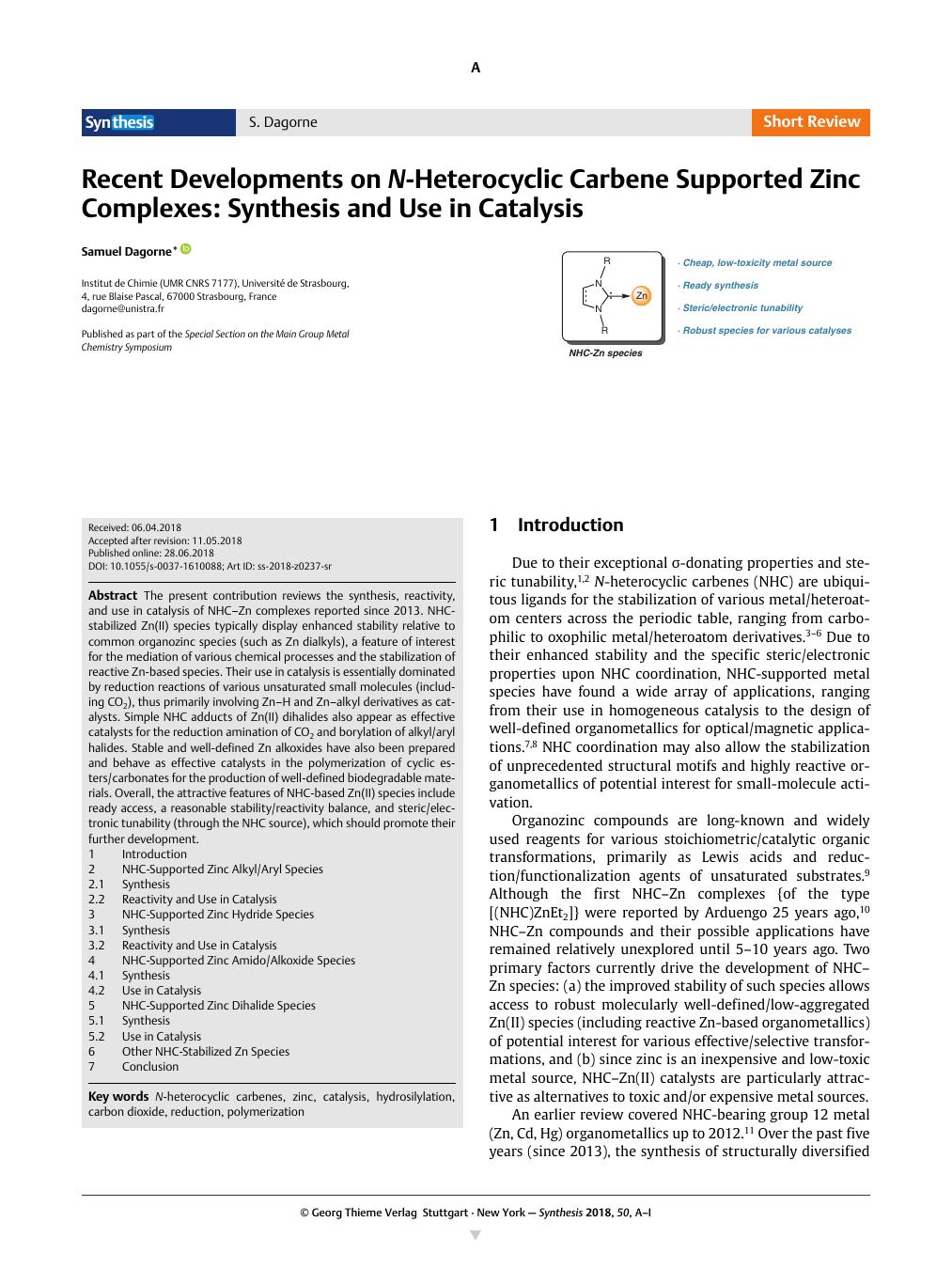Synthesis ( IF 2.6 ) Pub Date : 2018-06-28 , DOI: 10.1055/s-0037-1610088 Samuel Dagorne 1

|
Published as part of the Special Section on the Main Group Metal Chemistry Symposium
Abstract
The present contribution reviews the synthesis, reactivity, and use in catalysis of NHC–Zn complexes reported since 2013. NHC-stabilized Zn(II) species typically display enhanced stability relative to common organozinc species (such as Zn dialkyls), a feature of interest for the mediation of various chemical processes and the stabilization of reactive Zn-based species. Their use in catalysis is essentially dominated by reduction reactions of various unsaturated small molecules (including CO2), thus primarily involving Zn–H and Zn–alkyl derivatives as catalysts. Simple NHC adducts of Zn(II) dihalides also appear as effective catalysts for the reduction amination of CO2 and borylation of alkyl/aryl halides. Stable and well-defined Zn alkoxides have also been prepared and behave as effective catalysts in the polymerization of cyclic esters/carbonates for the production of well-defined biodegradable materials. Overall, the attractive features of NHC-based Zn(II) species include ready access, a reasonable stability/reactivity balance, and steric/electronic tunability (through the NHC source), which should promote their further development.
1 Introduction
2 NHC-Supported Zinc Alkyl/Aryl Species
2.1 Synthesis
2.2 Reactivity and Use in Catalysis
3 NHC-Supported Zinc Hydride Species
3.1 Synthesis
3.2 Reactivity and Use in Catalysis
4 NHC-Supported Zinc Amido/Alkoxide Species
4.1 Synthesis
4.2 Use in Catalysis
5 NHC-Supported Zinc Dihalide Species
5.1 Synthesis
5.2 Use in Catalysis
6 Other NHC-Stabilized Zn Species
7 Conclusion
The present contribution reviews the synthesis, reactivity, and use in catalysis of NHC–Zn complexes reported since 2013. NHC-stabilized Zn(II) species typically display enhanced stability relative to common organozinc species (such as Zn dialkyls), a feature of interest for the mediation of various chemical processes and the stabilization of reactive Zn-based species. Their use in catalysis is essentially dominated by reduction reactions of various unsaturated small molecules (including CO2), thus primarily involving Zn–H and Zn–alkyl derivatives as catalysts. Simple NHC adducts of Zn(II) dihalides also appear as effective catalysts for the reduction amination of CO2 and borylation of alkyl/aryl halides. Stable and well-defined Zn alkoxides have also been prepared and behave as effective catalysts in the polymerization of cyclic esters/carbonates for the production of well-defined biodegradable materials. Overall, the attractive features of NHC-based Zn(II) species include ready access, a reasonable stability/reactivity balance, and steric/electronic tunability (through the NHC source), which should promote their further development.
1 Introduction
2 NHC-Supported Zinc Alkyl/Aryl Species
2.1 Synthesis
2.2 Reactivity and Use in Catalysis
3 NHC-Supported Zinc Hydride Species
3.1 Synthesis
3.2 Reactivity and Use in Catalysis
4 NHC-Supported Zinc Amido/Alkoxide Species
4.1 Synthesis
4.2 Use in Catalysis
5 NHC-Supported Zinc Dihalide Species
5.1 Synthesis
5.2 Use in Catalysis
6 Other NHC-Stabilized Zn Species
7 Conclusion
中文翻译:

N-杂环碳基负载锌配合物的最新进展:合成及其在催化中的应用
作为主体金属化学专题讨论会特别部分的一部分出版
抽象的
本文稿回顾了自2013年以来报道的NHC-Zn络合物的合成,反应性和在催化中的用途。相对于常见的有机锌物种(例如二烷基锌),NHC稳定的Zn(II)物种通常显示出增强的稳定性,这是一个令人关注的特征用于介导各种化学过程和稳定反应性Zn基物质。它们在催化中的用途主要是各种不饱和小分子(包括CO 2)的还原反应,因此主要涉及Zn-H和Zn-烷基衍生物作为催化剂。Zn(II)二卤化物的简单NHC加合物也似乎是减少CO 2胺化的有效催化剂和烷基/芳基卤化物的硼化。还已经制备了稳定且界限分明的锌醇盐,并且在环状酯/碳酸酯的聚合反应中作为有效催化剂,用于生产界限分明的可生物降解材料。总体而言,基于NHC的Zn(II)物种的吸引人的特征包括易于获取,合理的稳定性/反应性平衡以及空间/电子可调性(通过NHC来源),这将促进它们的进一步发展。
1引言
2种NHC支持的锌烷基/芳基物种
2.1综合
2.2反应性及其在催化中的用途
3种由NHC支持的氢化锌
3.1综合
3.2反应性及其在催化中的用途
4种NHC支持的锌酰胺/醇盐物种
4.1综合
4.2在催化中的用途
5种NHC支持的二卤化锌物种
5.1综合
5.2在催化中的用途
6种经过NHC稳定化处理的锌物种
7结论
本文稿回顾了自2013年以来报道的NHC-Zn络合物的合成,反应性和在催化中的用途。相对于常见的有机锌物种(例如二烷基锌),NHC稳定的Zn(II)物种通常显示出增强的稳定性,这是一个令人关注的特征用于介导各种化学过程和稳定反应性Zn基物质。它们在催化中的用途主要是各种不饱和小分子(包括CO 2)的还原反应,因此主要涉及Zn-H和Zn-烷基衍生物作为催化剂。Zn(II)二卤化物的简单NHC加合物也似乎是减少CO 2胺化的有效催化剂和烷基/芳基卤化物的硼化。还已经制备了稳定且界限分明的锌醇盐,并且在环状酯/碳酸酯的聚合反应中作为有效催化剂,用于生产界限分明的可生物降解材料。总体而言,基于NHC的Zn(II)物种的吸引人的特征包括易于获取,合理的稳定性/反应性平衡以及空间/电子可调性(通过NHC来源),这将促进它们的进一步发展。
1引言
2种NHC支持的锌烷基/芳基物种
2.1综合
2.2反应性及其在催化中的用途
3种由NHC支持的氢化锌
3.1综合
3.2反应性及其在催化中的用途
4种NHC支持的锌酰胺/醇盐物种
4.1综合
4.2在催化中的用途
5种NHC支持的二卤化锌物种
5.1综合
5.2在催化中的用途
6种经过NHC稳定化处理的锌物种
7结论



























 京公网安备 11010802027423号
京公网安备 11010802027423号